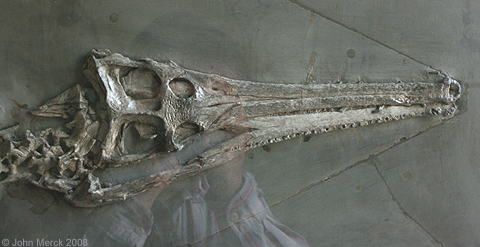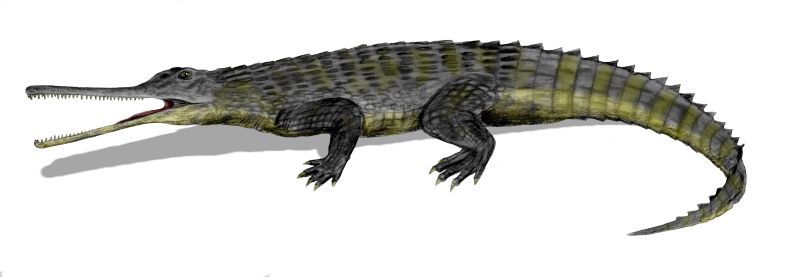[Recent Entries][Archive][Friends][User Info]
March 7th, 2012
| March 7th, 2012 | |
|---|---|
| 03:39 pm [industrialterro] [Link] |
Paleorhinus Paleorhinus was a genus of small phytosaur, a large order of semi-aquatic, crocodile-like animals that lived in the Late Triassic, specifically the earlier Late Carnian period. The reptiles lived throughout Europe, North America, and North Africa. This genus usually also includes the more appropriately named Parasuchus, which lived in India. Ebrachosuchus is an extinct genus of basal phytosaurid phytosaur. Fossils were first discovered from the Blasensandstein Formation near Ebrach, Germany, which dates back to the Carnian stage of the Late Triassic. The original holotype of E. neukami had a very elongate rostrum that was used to distinguish the genus from other phytosaurs. However, due to its many other similarities to the closely related Paleorhinus, Ebrachosuchus has since been considered to be synonymous with Paleorhinus. The rostrum length alone would not be enough to assign the original specimen of E. neukami to its own genus or subgenus, according to the authors of one paper proposing the synonymy.
Tags: Вымершие рептилии, Триас, архозавроморфы, архозавры, диапсиды, круротарзы, текодонты, фитозавры |
| Time | Event |
| 03:53 pm [industrialterro] [Link] |
Leptosuchus Leptosuchus is an extinct genus of phytosaur with a complex taxonomical history. Fossils have been found from the Dockum Group and lower Chinle Formation outcropping in Texas, New Mexico, and Arizona and date back to the Carnian stage of the Late Triassic. Currently there are believed to be four species of Leptosuchus. All species share in common a similar position of the temporal arch below the skull roof and a posterior process of the squamosal that extends farther than the paroccipital process. The type species is L. crosbiensis, which was named in 1922 on the basis of material found from Texas. L. adamanensis was first described in 1930 as a species of Machaeroprosopus from the Blue Mesa Member of Petrified Forest National Park, along with the other two species, L. lithodendrorum and L. gregorii. It was not until the publication of a 1995 paper on tetrapods of southwestern United States that these species were recognized as belonging to the genus Leptosuchus. However, because of the distinctive size of the rostral crest in L. gregorii, it was assigned to its own genus, Smilosuchus, in that same paper. Despite this, L. gregorii has recently been seen as belonging to Leptosuchus, as it is believed that the large, complete crest was independently developed in this particular species. The close relation of Leptosuchus and Machaeroprosopus with Rutiodon has led some paleontologists to believe that the prior two were synonymous with Rutiodon, with the latter's name having seniority. Differing features seen in the three phytosaurs have been attributed to sexual dimorphism, differing growth stages, or individual variation, while similarities could be seen in the rostral crest and the position of the nares. Previously it was believed that these were different genera due to the geographical isolation that could be seen in North American phytosaurs; Leptosuchus remains were found primarily in southern localities while Rutiodon remains could be found in more eastern localities. Other studies concluded that it was synonymous with Machaeroprosopus or Phytosaurus. One recent study has again found Leptosuchus to be congeneric with Rutiodon, but since then another study has suggested that its type species R. carolinensis, while still very similar to Leptosuchus, is synonymous with Angistorhinus. Smilosuchus meaning "deadly-knife crocodile" is an extinct genus of phytosaur from the Late Triassic of North America. It was first described in 1995 as a replacement generic name for Leptosuchus gregorii. Because of the large rostral crest it possessed, it was considered to be distinct enough from other species of Leptosuchus (all of which had smaller and more restricted crests) to be within its own genus. Despite this, recent studies seem to suggest that Smilosuchus is congeneric with Leptosuchus, as the enlarged crest could have been independently developed in Leptosuchus.
Tags: Вымершие рептилии, Триас, архозавроморфы, архозавры, диапсиды, круротарзы, текодонты, фитозавры |
| Time | Event |
| 04:25 pm [industrialterro] [Link] |
Mystriosuchus Mystriosuchus (meaning "spoon-crocodile") is an extinct genus of phytosaur that lived in the Late Triassic (middle Norian) in Europe. It was first named by Eberhard Fraas in 1896, and includes two species: M. westphali (formerly M. plieningeri) and the type species, M. planirostris. Mystriosuchus planirostris measured about four metres long (13 ft), according to a complete skeleton which was found in 1995. The postcranial anatomy of the skeleton suggests that Mystriosuchus was more adapted to aquatic life than other known phytosaurs, while cranial morphology is suggestive of a primarily fish eating diet. Mystriosuchus used to placed in its own subfamily, Mystriosuchinae, however, recent research demonstratred that it belongs to the subfamily Pseudopalatinae, despite having several physical differences from most of the genera in this group. Originally considered to be a freshwater genus, a recent specimen from Northern Italy has shown that some Mystriosuchus specimens lived a completely marine life.
Tags: Вымершие рептилии, Триас, архозавроморфы, архозавры, диапсиды, круротарзы, текодонты, фитозавры |
| Time | Event |
| 04:43 pm [industrialterro] [Link] |
Nicrosaurus Nicrosaurus is an extinct genus of phytosaur reptile. Although it looked and probably lived like a crocodile, it was not closely related to these creatures, instead being a good example of parallel evolution. The main difference between Nicrosaurus (and all other phytosaurs) and real crocodiles was the position of the nostrils - Nicrosaurus's nostrils were placed directly in front of the forehead, whereas in crocodiles, the nostrils are positioned on the end of the snout. A recent phylogenetic analysis found that the genera Pseudopalatus, Mystriosuchus, Redondasaurus and Nicrosaurus were pseudopalatines.
Tags: Вымершие рептилии, Триас, архозавроморфы, архозавры, диапсиды, круротарзы, текодонты, фитозавры |
| Time | Event |
| 04:52 pm [industrialterro] [Link] |
Redondasaurus Redondasaurus is a genus of phytosaur from the Late Triassic of North America. Translated, the name Redondasaurus means "Redonda lizard," referring to the Redonda Formation of east-central New Mexico, USA. It was first named by Hunt & Lucas in 1993, and contains one species, R. gregorii. It is the youngest and most evolutionarily-advanced of the phytosaurs. Redondasaurus was a carnivore and measured from 10 to 12 meters in length, 1.5 meters of which made up the length of the head, and 1.5 meters in height. They could reach a weight of up to 26,000 lbs. It likely spent most of its time in lakes and rivers, and ambushed its prey, which consisted of fish, small reptiles, and possibly dinosaurs. There is little columnar enamel in the teeth of Redondasaurus. A recent phylogenetic analysis found that the genera Pseudopalatus, Mystriosuchus, Redondasaurus and Nicrosaurus were pseudopalatines.
Размеры тела в сравнении с человеком:
Ископаемые останки (1, 2, 3, 4, 5):
Tags: Вымершие рептилии, Триас, архозавроморфы, архозавры, диапсиды, круротарзы, текодонты, фитозавры |
| Time | Event |
| 05:14 pm [industrialterro] [Link] |
Rutiodon Rutiodon ("Wrinkle tooth") is an extinct genus of archosaur belonging to the family Phytosauridae. It lived during the Late Triassic period, and was about 10 to 25 feet (3 to 8 meters) in length. The animal is known from fossils in Europe (Germany and Switzerland) as well as North America (Arizona, New Mexico, North Carolina, Texas, New York, New Jersey). Like other phytosaurs, Rutiodon strongly resembled a crocodile, but its nostrils were positioned far back on the head, close to the eyes, instead of at the tip of the snout. It had enlarged front teeth, and a relatively narrow jaw, somewhat resembling that of a modern gharial. This suggests that this carnivore probably caught fish and it may also have snatched land animals from the waterside. Also like modern crocodiles, its back, flanks, and tail were covered with bony armored plates.
Tags: Вымершие рептилии, Триас, архозавроморфы, архозавры, диапсиды, круротарзы, текодонты, фитозавры |
| Previous Day | 2012/03/07 [Archive] |
Next Day |






























